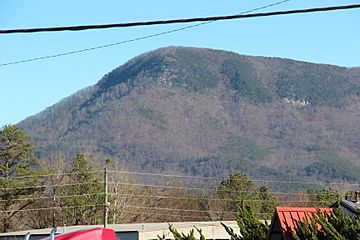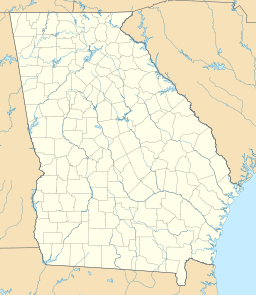Fort Mountain (Murray County, Georgia) facts for kids
Quick facts for kids Fort Mountain GA |
|
|---|---|

Fort Mountain, viewed from Chatsworth
|
|
| Highest point | |
| Elevation | 2,850 ft (870 m) |
| Prominence | 321 ft (98 m) |
| Geography | |
| Nearest city | Chatsworth, Georgia |
| Area | 211.2 acres (85.5 ha) |
| NRHP reference No. | 77001587 |
| Added to NRHP | November 23, 1977 |
Fort Mountain is a cool mountain in northern Georgia, near a town called Chatsworth. It's part of the Cohutta Mountains, which are a smaller section of the huge Appalachian Mountains. This mountain is also inside the Chattahoochee National Forest, a big natural area.
The most famous thing about Fort Mountain is an ancient rock formation or ruin. Nobody really knows who built it or why! This mysterious wall is why the mountain got its name. It's located inside Fort Mountain State Park. The wall is made of piles of stones in a long, wavy line that follows the mountain's edge. Some people say it's about 928 feet (283 meters) long, while others think it's around 855 feet (261 meters).
A stone fire tower, built a long time ago by the Civilian Conservation Corps, stands at the very top of the mountain. You can find it in the park. A hiking trail in the park leads to a beautiful spot where you can see the Cool Springs Valley. The park also has a mountain lake, cabins for rent, camping spots, and other public facilities.
Two main roads cross Fort Mountain, connecting Murray and Gilmer counties in Georgia. One is Georgia SR 52, a steep and winding road that goes between Chatsworth and Ellijay. It offers amazing views of the Cohutta Mountains. There's even a spot to pull over and enjoy the view. Another road, SR 282, crosses the mountain southeast of Chatsworth.
The Mystery of Fort Mountain's Wall
The most well-known part of Fort Mountain is the rock wall around its top. People often call it the ruins of an ancient fort or another structure made by humans. It's built from piles of stones without any mortar to hold them together.
Who Built the Stone Wall?
Local stories sometimes say the Cherokee people built it. However, experts believe it was built by an even older group of indigenous people. They think it was made during the Middle Woodland era, a very long time ago.
Georgia's Department of Natural Resources says the "mysterious 855-foot-long wall is thought to have been built by early Indians." They suggest it might have been a fort to protect against other groups or used for ancient ceremonies. Because of its importance for understanding prehistoric times, the site was added to the National Register of Historic Places in 1977.
Other Ideas About the Wall
There are other ideas about where the stone piles came from. Some people think the stone formations might have happened naturally. This could be from the way the mountain was formed, pushing up the land.
In the 1800s, some people thought that Hernando de Soto, a Spanish explorer, built it as a fort. They believed he made it to defend against the Creek people around 1540. However, historians later pointed out that de Soto was only in the area for less than two weeks. This means he likely didn't have enough time to build such a large wall.
One old legend says that the stone piles were built by a race of "moon-eyed people." These stories claim these people lived in the area even before the Cherokee. These interesting tales have been shared in history books, park brochures, and signs.



